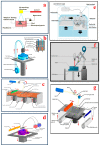The 3D Printing of Nanocomposites for Wearable Biosensors: Recent Advances, Challenges, and Prospects
- PMID: 38247910
- PMCID: PMC10813523
- DOI: 10.3390/bioengineering11010032
The 3D Printing of Nanocomposites for Wearable Biosensors: Recent Advances, Challenges, and Prospects
Abstract
Notably, 3D-printed flexible and wearable biosensors have immense potential to interact with the human body noninvasively for the real-time and continuous health monitoring of physiological parameters. This paper comprehensively reviews the progress in 3D-printed wearable biosensors. The review also explores the incorporation of nanocomposites in 3D printing for biosensors. A detailed analysis of various 3D printing processes for fabricating wearable biosensors is reported. Besides this, recent advances in various 3D-printed wearable biosensors platforms such as sweat sensors, glucose sensors, electrocardiography sensors, electroencephalography sensors, tactile sensors, wearable oximeters, tattoo sensors, and respiratory sensors are discussed. Furthermore, the challenges and prospects associated with 3D-printed wearable biosensors are presented. This review is an invaluable resource for engineers, researchers, and healthcare clinicians, providing insights into the advancements and capabilities of 3D printing in the wearable biosensor domain.
Keywords: 3D printing; biomedical; health monitoring; nanocomposites; wearable biosensors.
Conflict of interest statement
The authors declare no conflicts of interest. The funders had no role in the design of the study; in the collection, analyses, or interpretation of data; in the writing of the manuscript; or in the decision to publish the results.
Figures














Similar articles
-
3D Printing Technologies for Flexible Tactile Sensors toward Wearable Electronics and Electronic Skin.Polymers (Basel). 2018 Jun 7;10(6):629. doi: 10.3390/polym10060629. Polymers (Basel). 2018. PMID: 30966663 Free PMC article. Review.
-
Flexible and Wearable Biosensors for Monitoring Health Conditions.Biosensors (Basel). 2023 Jun 7;13(6):630. doi: 10.3390/bios13060630. Biosensors (Basel). 2023. PMID: 37366995 Free PMC article. Review.
-
Wearable biosensors in cardiovascular disease.Clin Chim Acta. 2024 Jul 15;561:119766. doi: 10.1016/j.cca.2024.119766. Epub 2024 Jun 8. Clin Chim Acta. 2024. PMID: 38857672 Review.
-
Field effect transistor based wearable biosensors for healthcare monitoring.J Nanobiotechnology. 2023 Nov 7;21(1):411. doi: 10.1186/s12951-023-02153-1. J Nanobiotechnology. 2023. PMID: 37936115 Free PMC article. Review.
-
Microfluidics by Additive Manufacturing for Wearable Biosensors: A Review.Sensors (Basel). 2020 Jul 29;20(15):4236. doi: 10.3390/s20154236. Sensors (Basel). 2020. PMID: 32751404 Free PMC article. Review.
Cited by
-
Bridging Nanomanufacturing and Artificial Intelligence-A Comprehensive Review.Materials (Basel). 2024 Apr 2;17(7):1621. doi: 10.3390/ma17071621. Materials (Basel). 2024. PMID: 38612135 Free PMC article. Review.
-
Nanoimprint Lithography for Next-Generation Carbon Nanotube-Based Devices.Nanomaterials (Basel). 2024 Jun 11;14(12):1011. doi: 10.3390/nano14121011. Nanomaterials (Basel). 2024. PMID: 38921886 Free PMC article.
-
Prospects and Trends in Biomedical Microelectromechanical Systems (MEMS) Devices: A Review.Biomolecules. 2025 Jun 18;15(6):898. doi: 10.3390/biom15060898. Biomolecules. 2025. PMID: 40563538 Free PMC article. Review.
-
3D Printed Nanosensors for Cancer Diagnosis: Advances and Future Perspective.Curr Pharm Des. 2024;30(38):2993-3008. doi: 10.2174/0113816128322300240725052530. Curr Pharm Des. 2024. PMID: 39161144 Review.
-
Nanomaterials for Energy Storage Systems-A Review.Molecules. 2025 Feb 14;30(4):883. doi: 10.3390/molecules30040883. Molecules. 2025. PMID: 40005192 Free PMC article. Review.
References
-
- Straits Research Wearable Sensors Market Size, Demand, Growth, Forecast Till 2030. August 2022. [(accessed on 12 November 2023)]. Available online: https://straitsresearch.com/report/wearable-sensors-market.
-
- Tu J., Torrente-Rodríguez R.M., Wang M., Gao W. The Era of Digital Health: A Review of Portable and Wearable Affinity Biosensors. Adv. Funct. Mater. 2020;30:1906713. doi: 10.1002/adfm.201906713. - DOI
-
- Lin Y., Bariya M., Javey A. Advanced Functional Materials. Volume 31. John Wiley and Sons Inc.; Hoboken, NJ, USA: 2021. Wearable Biosensors for Body Computing. - DOI
Publication types
Grants and funding
LinkOut - more resources
Full Text Sources

